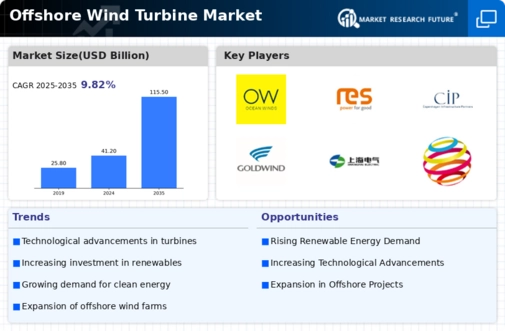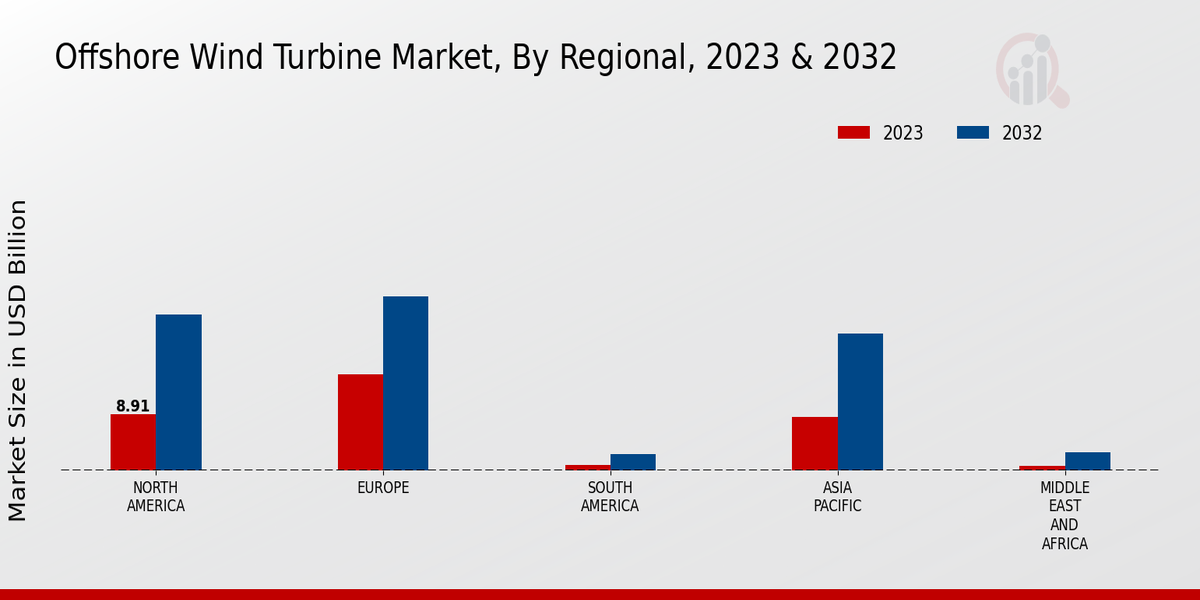Market Growth Projections
The Global Offshore Wind Turbine Market Industry is projected to experience substantial growth in the coming years. The market is expected to reach an estimated value of 41.2 USD Billion in 2024, with a remarkable increase to 115.5 USD Billion by 2035. This growth trajectory indicates a compound annual growth rate of 9.82% from 2025 to 2035. Such projections reflect the increasing global commitment to renewable energy and the expanding role of offshore wind in achieving energy transition goals. The market's expansion is likely to be fueled by technological advancements, supportive government policies, and rising investments in infrastructure.
Technological Advancements
Technological innovations in offshore wind turbine design and installation are pivotal for the growth of the Global Offshore Wind Turbine Market Industry. Enhanced turbine efficiency, larger rotor diameters, and improved materials contribute to higher energy output and lower costs. For example, advancements in floating wind turbine technology allow for deployment in deeper waters, expanding potential sites for wind farms. These innovations not only increase the feasibility of offshore projects but also attract investments. The market is expected to witness a compound annual growth rate of 9.82% from 2025 to 2035, driven by these technological advancements that enhance operational efficiency and reduce the levelized cost of energy.
Global Energy Security Concerns
Concerns regarding energy security and dependence on fossil fuels are propelling the Global Offshore Wind Turbine Market Industry. Countries are increasingly recognizing the need to diversify their energy sources to mitigate risks associated with geopolitical tensions and fluctuating fossil fuel prices. Offshore wind energy offers a stable and sustainable alternative, reducing reliance on imported fuels. As nations strive for energy independence, the demand for offshore wind projects is likely to surge. This shift towards renewable energy sources is expected to contribute to the market's growth trajectory, as countries invest in offshore wind to enhance their energy security and sustainability.
Government Policies and Incentives
Supportive government policies and financial incentives play a crucial role in propelling the Global Offshore Wind Turbine Market Industry. Many countries are establishing ambitious renewable energy targets and providing subsidies for offshore wind projects. For instance, the United States has set a goal of deploying 30 gigawatts of offshore wind capacity by 2030, fostering a favorable environment for investment. These initiatives not only stimulate market growth but also encourage research and development in the sector. As a result, the market is anticipated to grow significantly, potentially reaching 115.5 USD Billion by 2035, as governments continue to prioritize renewable energy in their energy transition strategies.
Rising Demand for Renewable Energy
The increasing global emphasis on renewable energy sources drives the Global Offshore Wind Turbine Market Industry. Governments worldwide are implementing policies and incentives to reduce carbon emissions and combat climate change. For instance, the European Union aims to achieve climate neutrality by 2050, which necessitates a substantial increase in renewable energy capacity. Offshore wind energy, with its high efficiency and capacity factors, is a crucial component of this strategy. As a result, the market is projected to grow significantly, reaching an estimated value of 41.2 USD Billion in 2024, reflecting the urgent need for sustainable energy solutions.
Growing Investment in Infrastructure
The Global Offshore Wind Turbine Market Industry benefits from increasing investments in infrastructure development. As countries seek to enhance their energy security and transition to cleaner energy sources, substantial investments are being made in offshore wind farms and related infrastructure. This includes the construction of ports, grid connections, and maintenance facilities, which are essential for the successful deployment of offshore wind projects. The influx of capital not only supports the growth of the market but also creates job opportunities in various sectors. Consequently, the market is poised for robust growth, driven by the need for comprehensive infrastructure to support expanding offshore wind capacities.

















